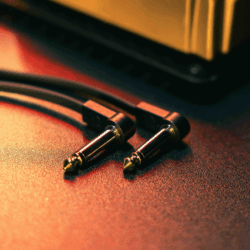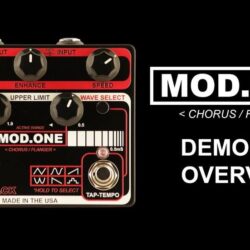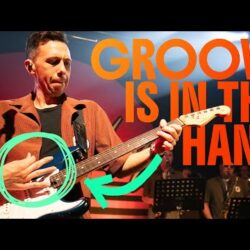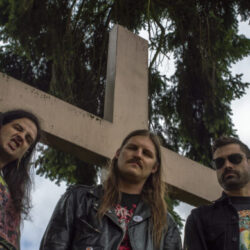
New Flat Patch Cables Join Gator Cableworks’ Composer Series
Tight spacing between pedals calls for a tighter cable approach. Gator Cableworks now offers a space-saving option with the launch of Flat Patch Cables, available as part of its Composer Series collection of high-quality audio cables.The Composer Series Flat Patch Cables are built for musicians who demand premium signal integrity and efficient pedalboard management. Each cable features slim, compact connectors that fit into tight spaces and adapt to a variety of challenging pedal layouts, helping reduce clutter and maximize usable surface area on crowded boards.Engineered for high performance, the cables feature 99.99% oxygen-free copper conductors to ensure clear signal transmission. The 24 AWG low capacitance construction helps preserve tone while minimizing interference, and a double-shielding layer delivers a 100% shielding factor to guard against noise and RF disruption.Each cable includes TS male right-angle ¼-inch connectors with nickel-plated housing and 24K gold-plated contact tips, providing optimal conductivity and corrosion resistance for long-term reliability.The Composer Series Flat Patch Cables are available in the following sizes and pack options: 3-inch, 6-inch, 12-inch and 24-inch lengths, as well as 3-packs of 3-inch, 6-inch and 12-inch models. All Cableworks cables are backed by a Limited Lifetime Guarantee. For more information, please visit www.gatorco.com.
Read more »Lyric Video Premiere: Dreams of Gray – “Across the Endless Sea”
Dreams of Gray lean into the sad and introspective with their new EP, A Beginning, out September 5. Check out the lyric video for for “Across the Endless Sea” ahead of the release.
The post Lyric Video Premiere: Dreams of Gray – “Across the Endless Sea” appeared first on Decibel Magazine.

Mr. Black Creates a Powerful Analog Time-Modulator
Continuing to shatter the boundaries of what is possible within the analog time-modulation domain, Mr. Black is proud to announce the all-new Mod.One – Analog Modulator. The Mod.One combines chorus, flanger and “high-band” flanger into a single compact pedal, readily capable of creating each effect independently, and further expanded by its ability to seamlessly morph between these processes on the fly, bridging the gaps between the classic, related modulation sounds, while affording all-new tones and possibilities. Hand built and individually calibrated, the Mod.One also includes Click-Less relay true-bypass, six waveforms and precision tap-tempo, delivering premium analog modulation in a built-to-last compact and handsome package.Key features:• 100% analog signal path • Wide range of LFO speeds • Six waveforms • Tap-Tempo • Click-Less True-Bypass • Powered by “Industry Standard” 9VDC The Mod.One carries a MAP of $249.95 and is handmade, one-at-a-time in Portland, Oregon U.S.A. Available at: www.mrblackpedals.com and retailers worldwide.
Read more »
Hammer Time: How a New Tool Is Changing How Luthiers Understand Tonewood
Over the past few decades, I’ve devoted much of my lutherie career to understanding musical-grade tonewoods and the instruments that they become. While some builders seem to assess wood instinctively, I’ve always needed real, solid data—something concrete to show how a material behaves and how to best use it. That meant diving deep into the science: analyzing frequency, weight, and stiffness to understand how, and why, these characteristics shape an instrument’s sound.One of the most powerful tools for this kind of work is the FFT (Fast Fourier Transform) analyzer, which lets you track and study anything that vibrates or makes sound. When testing tonewoods or working on guitars, FFT analysis is indispensable. Over the years, I tried a variety of FFT systems, but eventually adopted SpectraPlus by Pioneer Hill Software. It elevated my analysis to a whole new level. Even mobile FFT apps, though a bit quirky at times, have their place. I’ve had one on my phone for over 15 years. They’re a great entry point for players and curious minds alike.In 2024, a major breakthrough occurred: the launch of the Acousonix Sonic Hammer, which I helped develop. This handheld device detects and displays the primary resonant frequencies of almost anything you tap. For tonewoods, it reveals key modal frequencies that help gauge a piece of wood’s acoustic potential. For guitars, it’s both insightful and fun: You can tap the top to measure its resonance, hold it near the soundhole to detect air resonance, or tap the back to read the back plate’s voice. Together, these readings paint a clearer picture of the instrument’s tonal fingerprint.Say you’re comparing two guitars: One feels more “alive,” but you can’t explain why. By sampling each guitar you’ll likely see frequency differences tied to weight, tension, and structural behavior. That kind of information can help guide buying decisions, repair work, or just satisfy your curiosity.Although we originally developed the Sonic Hammer for tonewood analysis, its applications have since expanded. With smart software updates and continued experimentation, we’ve used it to fine-tune banjo heads, drums, archtop guitars, and even ukuleles. Today, it’s being used in studios, repair shops, manufacturing facilities, and by tonewood sawyers to help improve yield, quality control, and efficiency.It’s no surprise that everyday players, collectors, and music shops have embraced the hammer, not just for smarter purchases, but to better understand their instruments, inventories, and collections. Once a guitar’s sonic footprint is captured, you can track it over time. Whether it’s aging, humidity, or environmental shifts, this tool provides a simple way to monitor and preserve an instrument’s acoustic health. In recording studios or on the road, if an instrument is problematic, the hammer helps engineers and guitar techs zero in on where the problem may lie. While broader implications are still unfolding, the technology is already proving both rewarding and, yes, a little disruptive. But in time, this kind of data will likely become standard in the industry. “This handheld device detects and displays the primary resonant frequencies of almost anything you tap.”The Founders Edition focused on detecting primary resonances, but what’s coming next is even more exciting: deeper analysis of voicing, damping, and admittance, plus built-in Bluetooth for integration with more advanced systems. Most importantly, this tool can support something I’ve long believed in: responsible tonewood use. If we want to conserve the world’s most valuable musical materials, we need smarter ways to measure and manage them. I believe the Sonic Hammer can play a meaningful role in that effort.For guitar makers and players, we’re living in a truly exciting era. For years, I said, “This is going to take off,” and every couple of years it felt just around the corner. But during the COVID shutdown, something changed. People had time to explore, to experiment, and the science of acoustics started to catch fire. These are exciting times indeed.For more info, visit acousonix.com.
Read more »
Cory Wong: How I Developed My Strumming Technique | Pick Hand Exercises
For tab, head to: https://www.guitarworld.com/lessons/artist-lessons/cory-wong-pick-hand-strumming-secrets In this column, Cory shares the exercises he uses to develop solid pick-hand timing when strumming. #CoryWong #rhythmguitar #guitarlesson
Read more »
DiMarzio Launches Colossal™ Neck & Bridge Pickups for 5-String Bass
Living up to its name, “Colossal,” this pickup set has more of everything. Play them softly and they deliver an unmatched airiness to the notes; play them aggressively and they will blow your hair back. These passive pickups are designed to effortlessly respond to soft touch, slap, or aggressive pick attack with ease.As with our game changing Relentless™ pickups, we removed all the hard edges from the metal covers, and added an arch to the top contour, bringing the sensing coils closer to the middle strings. These improvements increase the string balance and overall dynamic range.The Colossal™ pickups are a fully humbucking design and are completely shielded, making them a better choice for both recording and live shows. These pickups can be used with the coils in series, parallel, or split configurations, making multiple sounds easily achievable without the need for digital filters. The Colossal™ Bridge and Neck can easily be combined with active electronics.Using a thick .09375” circuit board baseplate as the foundation, the Colossal™ pickups are simple to install and use our quick connect cable system. The soapbar shaped (EMG40® sized, 37.75mm x 101.25mm) pickups incorporate Neodymium magnets, producing significantly more output and dynamic range than traditional active or passive pickups.To improve the balance when both pickups are used together, we made the bridge position pickup louder than the neck position pickup. When the pickups are blended, you get a better volume match.Colossal™ pickups have a richly detailed mid-range that growls, delivering notes with definition and openness, and they work well with dropped tunings. The highs are present and precise without harshness, and the lows are thunderous and tight, like the footsteps of a giant.Available in Nickel, Gold, or Matte Black finishes.
Read more »Full Album Stream: Faetooth – “Labyrinthine”
It’s only September, but the haunting of this year’s spooky season has already begun with Faetooth’s new doomy masterwork.
The post Full Album Stream: Faetooth – “Labyrinthine” appeared first on Decibel Magazine.

Track Premiere: Ripping Remains – ‘Rub My Infection On You’
From the ashes of Pacific Northwest death dealers Dripping Decay comes Pacific Northwest death dealers Ripping Remains.
The post Track Premiere: Ripping Remains – ‘Rub My Infection On You’ appeared first on Decibel Magazine.
Album Premiere: Duo-Lingual Epic Storytelling with Shardana’s The Monarch
Check out the new album by Sardinian storytellers, Shardana!
The post Album Premiere: Duo-Lingual Epic Storytelling with Shardana’s The Monarch appeared first on Decibel Magazine.

Linkin Park Rig Rundown
Linkin Park went on hiatus for seven years after lead vocalist Chester Bennington’s death in 2017, but last September, the band announced that they were returning with new music and a new lineup—including vocalist Emily Armstrong and drummer Colin Brittain. A new album, From Zero, was released in November 2024, followed by the single “Up From the Bottom” earlier this year, and this summer, the band tore off on an international arena and stadium comeback tour. Founding lead guitarist Brad Delson is still a creative member of the band, but has elected to step back from touring. And so on the road, Alex Feder takes his place alongside founding guitarist/vocalist/keyboardist Mike Shinoda, DJ Joe Hahn, and bassist Dave Farrell.PG’s Chris Kies headed to downtown Nashville’s Bridgestone Arena to meet up with Mike Shinoda, plus techs Mark, Ben, and Tracy, to learn how the band pulled off their much-anticipated gigs this year. [Brought to you by D’Addario.]Boredom BeaterThis is Shinoda’s “workhorse” Strat, a longtime trusted pal that’s featured on songs like “What I’ve Done.” There have been plenty of times when Shinoda gets bored on tour, and at one point, he started painting his guitars to keep himself occupied—including this Strat.Painted PRSThis PRS is from the band’s Meteora-era, a definitive instrument in the early years of the band. Again, the guitar’s aesthetic customizations were executed by Shinoda himself, with ink markers, spray paint, and a paint pen—plus some custom “etchings” on the fretboard. This and his other guitars are outfitted with custom Kill Spencer straps.BlackoutThis black Gibson SG came into the picture around Linkin Park’s third record, 2007’s Minutes to Midnight.Empty SpacesWith new vocalist Armstrong’s voice filling a different spot in the band’s sound, Shinoda has adjusted some of his tunings and playing. This Fender Blacktop Baritone Telecaster helps give Armstrong’s voice space and keeps everyone in their sweet spots, frequency-wise.Hybrid Theory HeavyThis 2008 PRS Custom 24 is a replica of Delson’s Hybrid Theory-era PRS, and sports Paul Reed Smith’s autograph on the back. It lives in drop C-sharp tuning, and if Delson is playing it, it’s loaded with D’Addario NYXLs (.010-.052). When Feder’s at the wheel, he goes for heavier top strings mixed with Delson’s packs, for a gauge range of .054-.044-.032-.017-.013-.010.Another PRS, finished in grey and tuned to drop D sharp, features the Minutes to Midnight logo and gets brought out for “One Step Closer.” A sunburst PRS DC3 is equipped with even heavier strings for a drop A tuning: A-E-A-D-G-B.’61 StandardThis Fender Custom Shop Rory Gallagher Stratocaster has become a staple of the live show. It’s part of a set of three that were created for Delson, designed and relic’d to mimic a 1961 Standard Stratocaster. It stays in drop D, with Delson’s standard .010-.052 strings. He uses .72mm Dunlop picks, while Feder uses slightly heavier .88mm picks.Mike Shinoda, Brad Delson, and Alex Feder’s Rack SystemsDelson’s rig (used by touring member Alex Feder) lives on the left side of this rack, while Shinoda’s takes up the right. They both include a Radial KL-8, two Radial JX44s, two Shure AD4Qs, and two Fractal Axe-Fx III units. Shinoda’s setup also includes two Electro-Harmonix HOG2 pedals. The fractals use IRs that were captured by old FOH engineer Pooch, using a Randall cabinet.MIDI handles all of the changes for the show, though there’s a Fractal FC-12 foot controller on hand in case of emergency for manual switching. Fred Carlton of Nerdmatics, who built the Linkin Park rig for this 2024-2025 run promoting From Zero, shared some more information with us after filming: “The backline gear consists of about 11 computers running Ableton, all receiving locator information from the main playback computers. We maintain redundant computer systems for Joe Hahn’s DJ rig, Mike Shinoda’s keyboard rig, the Audio FX rig, and the Playback system. Single-computer setups are used for both guitar rigs and the bass rig, as these stations only send MIDI patch changes and do not handle audio. Additional single-computer systems are in place at Monitor World, FOH, and within the Visual department.Each station carries an updated timeline of the show, allowing techs to insert automation data such as MIDI or timecode to control their systems. Once changes are made to the main Ableton session, we distribute updated .ALS files to all departments, enabling them to integrate their specific data into the new timeline. This workflow allows us to implement changes quickly while keeping all departments aligned. Having separate computers also gives each tech the ability to test their own system independently. In the event of losing RTP network connectivity, they can punt the show locally without relying on external automation.”Sharpened with PrecisionThis Fender Custom Shop Precision bass is Dave Farrell’s go-to, his tech Tracy explains. It’s tuned to either drop D or standard, and Farrell uses Ernie Ball Bass Hybrid Slinky strings (.045-.105) with Dunlop .88mm picks.Ernie Ball BasherThis beloved Ernie Ball Music Man StringRay, with active electronics and neck-through construction, is the second-most used bass in the rack, and comes out for hits like “Papercut” and “In the End.” It’s tuned to drop C-sharp.Mum Knows BestThough his other StingRay gets more play, this is the original item, which Farrell’s mother bought for him. It gets tapped for tracks “Somewhere I Belong” and “Faint.”Dave Farrell’s RackAlong with the same accoutrements (Radial KL 8 and JX 44, Shure AD4Q), Farrell also uses a pair of Fractal Axe-Fx IIIs, and runs three signals—one of an Ampeg SVT model, a Marshall JMP-1 model, and a clean direct signal, run through emulations of two Ampeg 4×10 speaker cabinets—to front of house, which can mix and match between the three as needed. Fender StratocasterPRS Custom 24Gibson SGD’Addario NYXLFender Custom Shop Rory Gallagher Stratocaster.72 mm Dunlop PicksDunlop .88 mm PicksRadial KL-8Radial JX44Shure AD4QFender Custom Shop Precision bassErnie Ball Bass Hybrid Slinky Strings (.045-.105)Ernie Ball Music Man StingRay
Read more »